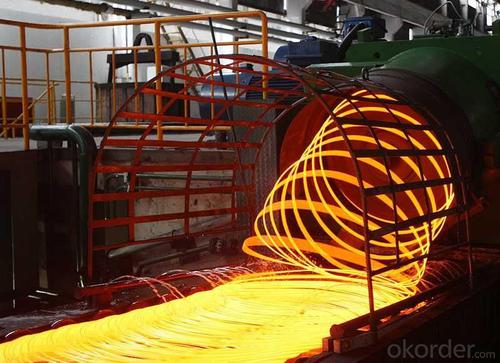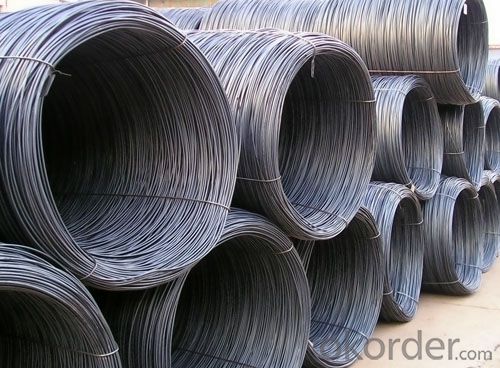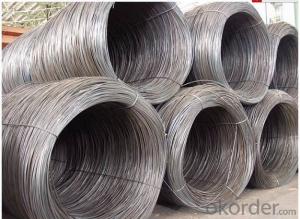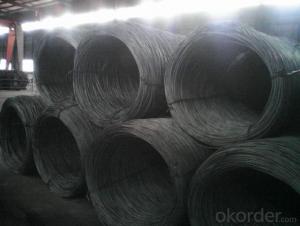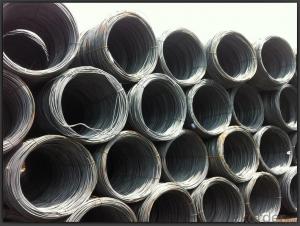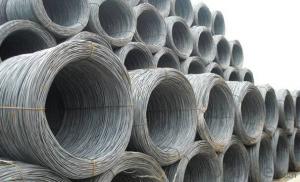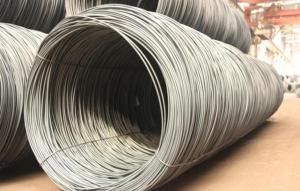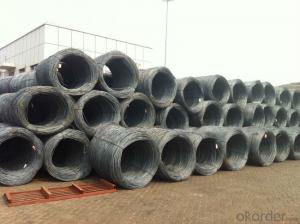wholesale High quality SAE1008B Steel Wire Rod
- Loading Port:
- Tianjin
- Payment Terms:
- TT or LC
- Min Order Qty:
- 20 m.t
- Supply Capability:
- 50 m.t/month
OKorder Service Pledge
OKorder Financial Service
You Might Also Like
Specifications of Wire Rod SAE1008B:
Grade: SAE1008B Standard: ASTM
Diameter: 9mm, 10mm, 11mm, 12mm
Alloy or Not: Alloy
Technique: Hot Rolled Place of Origin: China Mainland
Chemical Composition:
Please kindly find our chemistry of our material based on SAE1008B as below for your reference:
Grade | Chemical Composition (%) | |||||
C | Mn | S | P | Si | B | |
SAE1008B | 0.10max | 0.30-0.50 | 0.050max | 0.040max | 0.30max | 0.0008min |
Mechanical properties | ||||||
Yield strength(N/mm2) | Tensile strength(N/mm2) | Elongation (%) | ||||
≥195 | 350-380 | ≥32 | ||||
Usage and Applications of Wire Rod SAE1008B:
After hot-rolled the products shaped into coil and delivery as finished product, including round, square,rectangular, hexagonal and so on. Since most of the products are round, it is generally called wire rod. Carbon steel wire rod is widely used in construction and manufacturing. Carbon steel wire rod is mainly used for reinforcement of reinforced concrete and welded structure or reprocessed (roberts , nail, etc.) materials, especially used to produce wire drawing, welding electrode, nails, spring, electronic, precise machinery parts and so on.
Packaging & Delivery of Wire Rod SAE1008B:
Packaging Detail: products are packed in coil and then shipped by container or bulk vessel
Each coil weight: About 2.05MT
Delivery Detail: within 45 days after received deposit or LC.
Label: to be specified by customer, generally, each bundle has 1-2 labels
Trade terms: FOB, CFR, CIF
*If you would like to get our price, please inform us the size, standard/material and quantity. Thank you very much for your attention.
SAE1008 is the American Association of Automotive Engineers standards, 10 representative of the Mn below 1%, 08 on behalf of carbon content;
SAE is the U. S.Steel representation
ASTM Department of the American Institute of materials and test abbreviation, the full name is American
For Testing and Materials Society.
Standard A568/A568M-03
For Steel Specification, Sheet, Carbon, High-Strength and, Low-Alloy, Hot-Rolled
Cold-Rolled General, Requirements for and)
Sae1008 material equivalent to the national standard of "quality carbon structural steel, quality carbon structural steel is less than 0.8% carbon steel containing, contained in the steel sulfur, phosphorus, and non-metallic inclusions in less than carbon structural steel, mechanical performance is excellent.
Steel wire refers to the diameter of 5-22mm hot rolled bar or the cross section of the deformed steel. Steel wire generally made of ordinary carbon steel and high carbon steel. According to the different steel distribution directory and use, the steel wire including ordinary hot-rolled carbon steel, high carbon steel wire rod, carbon welding rod, quenching and tempering threaded rod, wire rope with wire, piano wire wire and stainless steel wire rod and so on.
The steel wire is mainly used for reinforcement of reinforced concrete and the welding or re processing (such as wire drawing, nail making material etc.). According to the steel distribution directory, wire including ordinary low carbon steel hot rolled wire, welding wire, blasting line wire, Quenched and tempered threaded rod, high quality wire rod.
Wire is a large amount of steel varieties.
China is the world's largest producer of steel wire rod, the annual output of more than 1/3 of the total production of the world.
- Q: How is steel wire rod recycled at the end of its lifecycle?
- Steel wire rod is typically recycled at the end of its lifecycle through a process called steel scrap recycling. This involves collecting the steel wire rod scrap from various sources such as manufacturing waste, construction sites, and end-of-life products. The collected scrap is then sorted and cleaned to remove any contaminants. Next, the scrap is melted down in electric arc furnaces or basic oxygen furnaces to produce molten steel. Subsequently, the molten steel is cast into new wire rod shapes through processes like continuous casting or hot rolling. Finally, the newly produced wire rod is used in various industries to manufacture different products, ensuring a sustainable and efficient utilization of steel resources.
- Q: How is steel wire rod inspected for dimensional accuracy?
- Steel wire rod is inspected for dimensional accuracy using various methods and tools. One of the common methods is the use of a caliper or micrometer to measure the diameter of the wire rod at different points along its length. This ensures that the wire rod meets the required specifications in terms of diameter. Another important aspect of dimensional accuracy is the roundness of the wire rod. To inspect roundness, a roundness tester is used, which measures the deviation of the wire rod from a perfect circle. This helps to ensure that the wire rod is uniform and free from any irregularities. In addition to diameter and roundness, the straightness of the wire rod is also inspected. This is done by placing the wire rod on a surface plate or straight edge and visually inspecting for any deviations from a straight line. Any bends or twists in the wire rod can affect its performance and suitability for various applications, so it is crucial to ensure its straightness. Furthermore, the surface quality of the wire rod is also inspected. This involves visual inspection for any surface defects such as scratches, pits, or any other irregularities that may affect the wire rod's performance or appearance. Overall, the dimensional accuracy of steel wire rod is inspected using a combination of measurement tools, visual inspection, and specialized testing equipment. This ensures that the wire rod meets the required specifications and is suitable for its intended use.
- Q: How is the quality of steel wire rod measured?
- The quality of steel wire rod is measured through a series of tests and evaluations to assess its mechanical properties, chemical composition, and overall performance. The key parameters used to determine the quality of steel wire rod include: 1. Tensile Strength: This test measures the maximum amount of stress a wire rod can withstand before breaking or experiencing deformation. It indicates the rod's ability to bear weight and resist tension. 2. Yield Strength: This test determines the level of stress at which the wire rod begins to deform permanently. It indicates the rod's ability to return to its original shape after being subjected to stress. 3. Elongation: This test measures the percentage increase in length of the wire rod before it breaks under tension. It provides insights into the rod's ductility and ability to elongate without losing its integrity. 4. Hardness: This test determines the resistance of the wire rod to indentation or scratching. It provides an indication of the rod's strength and durability. 5. Chemical Composition: The composition of the steel wire rod is analyzed to ensure it meets the required standards and specifications. It includes evaluating the levels of carbon, manganese, silicon, sulfur, phosphorus, and other alloying elements. 6. Surface Quality: The wire rod's surface is inspected visually and sometimes through microscopic analysis to detect any defects, such as cracks, scratches, or impurities. A smooth and clean surface is crucial for optimal performance. 7. Dimensional Accuracy: The wire rod's diameter and length are measured to ensure they meet the specified tolerances. Any deviations from the required dimensions can affect the rod's usability in various applications. 8. Microstructure Analysis: This examination involves detailed observation of the wire rod's internal structure using microscopy. It helps identify the presence of any abnormalities, such as grain size, inclusions, or segregation, that may impact its strength and performance. By conducting these tests and evaluations, manufacturers can ensure that the steel wire rod meets the required quality standards and is suitable for its intended applications, such as manufacturing wire products, reinforcing materials, or springs.
- Q: How are steel wire rods used in the production of piano wire?
- Steel wire rods are used in the production of piano wire by being drawn through a series of dies to gradually reduce their diameter. This process, known as wire drawing, results in a long, thin, and high-tensile strength wire that is then coiled, hardened, and tempered to create the strong and resilient piano wire used in piano strings.
- Q: How is steel wire rod used in the production of electrical cables?
- Steel wire rod is used in the production of electrical cables as it provides strength and durability. It is typically used as the core or reinforcement within the cable to enhance its mechanical properties and ability to withstand tension. The steel wire rod acts as a conductor, allowing the flow of electricity, while also offering protection against external forces and preventing the cable from stretching or breaking.
- Q: What are the different sizes and dimensions available for steel wire rod?
- The sizes and dimensions available for steel wire rods can vary depending on the manufacturer and the specific requirements of the customer. Common sizes range from 5.5mm to 20mm in diameter, with lengths typically ranging from 2,000mm to 6,000mm. However, it is important to note that custom sizes and dimensions can also be produced to meet specific project needs.
- Q: What are the different types of steel wire rod finishes available?
- There are several different types of steel wire rod finishes available, including bright finish, black finish, galvanized finish, and coated finish.
- Q: What are the potential applications of stainless steel wire rod?
- Stainless steel wire rod has a wide range of potential applications due to its strength, durability, and corrosion resistance. It can be used in the construction industry for reinforcing concrete structures, in the automotive industry for manufacturing various components, in the medical field for surgical instruments, and in the aerospace sector for aircraft manufacturing. Additionally, it is commonly utilized in the production of kitchenware, electrical appliances, and various industrial equipment.
- Q: What are the main factors affecting the market reputation of steel wire rod?
- The main factors affecting the market reputation of steel wire rod include its quality, durability, pricing, availability, and compliance with industry standards. Additionally, factors such as customer satisfaction, brand reputation, and effective marketing strategies also play a vital role in shaping the market reputation of steel wire rod.
- Q: How is steel wire rod tested for non-destructive defects?
- Steel wire rod can be tested for non-destructive defects using various methods including ultrasonic testing, magnetic particle testing, eddy current testing, and visual inspection. Ultrasonic testing involves the use of high-frequency sound waves to detect any internal flaws or defects in the rod. Magnetic particle testing uses magnetic fields and iron particles to identify surface cracks or defects. Eddy current testing utilizes electromagnetic induction to detect any surface or near-surface defects. Lastly, visual inspection involves a thorough visual examination of the wire rod to identify any visible defects or irregularities. These non-destructive testing methods ensure the quality and integrity of steel wire rod without causing any damage or destruction.
Send your message to us
wholesale High quality SAE1008B Steel Wire Rod
- Loading Port:
- Tianjin
- Payment Terms:
- TT or LC
- Min Order Qty:
- 20 m.t
- Supply Capability:
- 50 m.t/month
OKorder Service Pledge
OKorder Financial Service
Similar products
Hot products
Hot Searches
Related keywords



